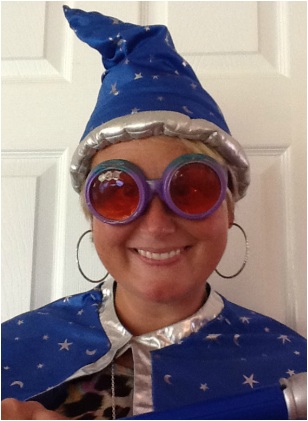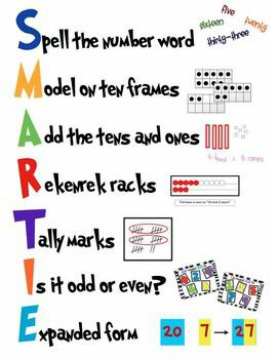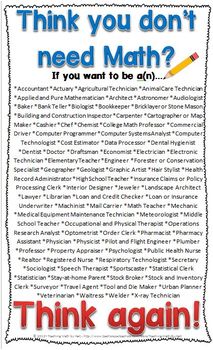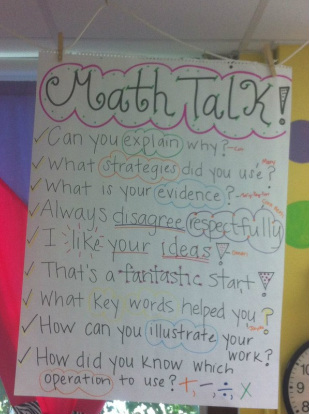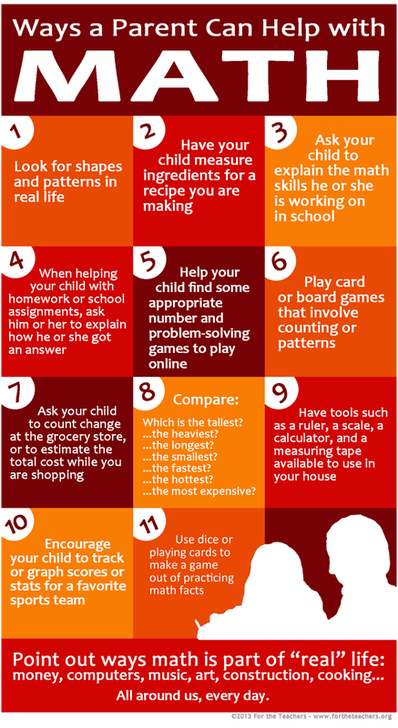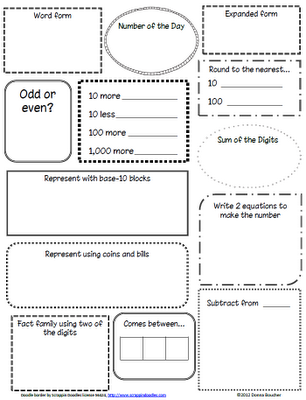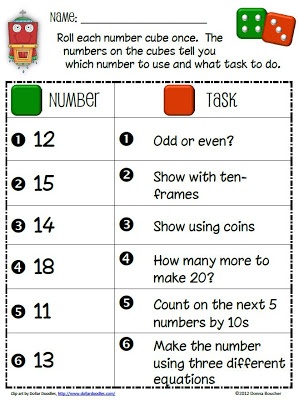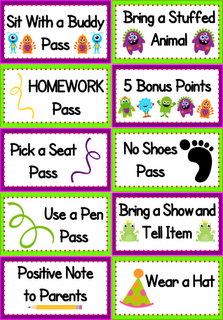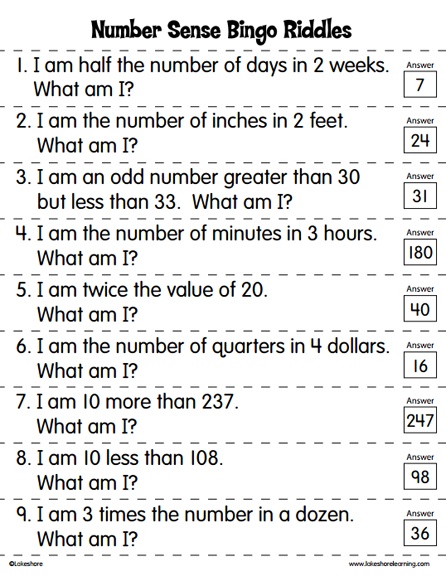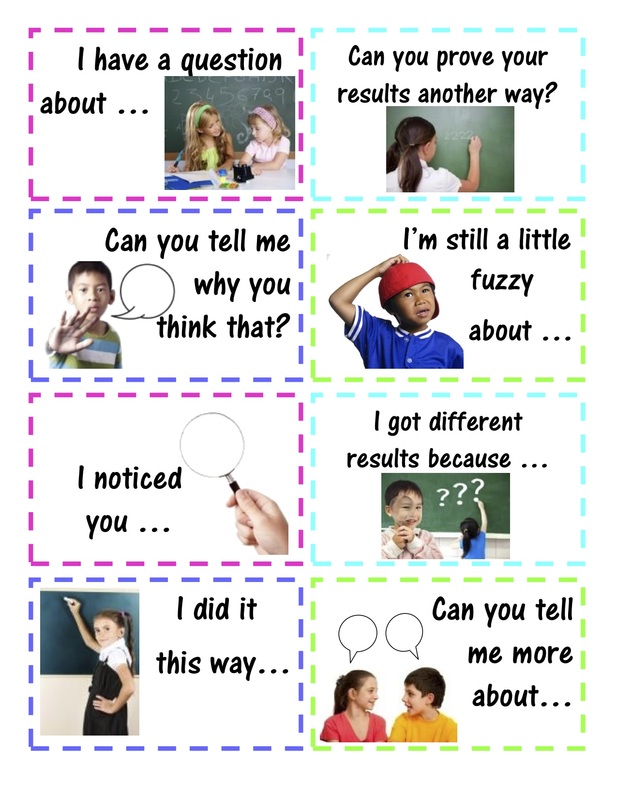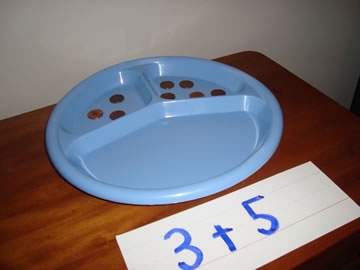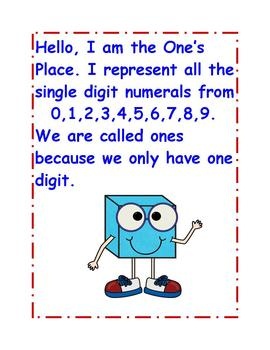Meet Your Math Wizard: Leigh Twigg
Many of your schools have a strategies block. Here are some great games and activities that can be used for review or enrichment at a variety of levels. Download Below....
| lets_make_math_fun.pdf | |
| File Size: | 3174 kb |
| File Type: | |
Download Think you don't need MATH poster below....
| thinkyoudontneedmathfreeposter.pdf | |
| File Size: | 1330 kb |
| File Type: | |
The DYnamic Paper Tool from the Illuminations Website is AWESOME! Great for making individualized number lines, spinners, shapes, pattern blocks, nets,.... Check it out!!
| math_mania.pdf | |
| File Size: | 275 kb |
| File Type: | |
| rollin_with_robots.pdf | |
| File Size: | 300 kb |
| File Type: | |
| positivebehaviorcoupons.pdf | |
| File Size: | 643 kb |
| File Type: | |
Great Questioning Tips....
Mental Math Strategies- Video and Activities
Great interactive math games- for ALL levels. CHECK IT OUT!
Math Task Cards: Nice addition to calendar or as a brain warm up. Download Below
| mathproblemsandmathbrainteasersfreebie.pdf | |
| File Size: | 1991 kb |
| File Type: | |
Place Value Discs
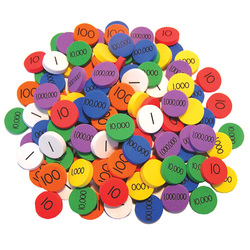
Base ten blocks are a great manipulative when teaching place value. As numbers get larger, however the base ten blocks can get a little overwhelming. Some of you may have found place value discs in your MiF manipulatives kit. I really recommend place value disc to model place value. If you don't have place value discs, you can make them easily. I bought colored chips (like poker chips) from Oriental Trading and made my own. Below you can download some place value discs to print off.
| singaporemathdiscs.doc | |
| File Size: | 37 kb |
| File Type: | doc |
E is for EXPLORE! I love this idea. Students build an initial and count place value. They could also create a picture!
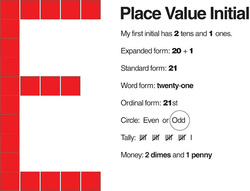
E is for Explore Blog is a great resource. This website has lots of interesting ideas to help you in a variety of subjects. Check it out by clicking on the red button.
Another E is for EXPLORE idea!

Click the button for a great website on place value. Lots of downloads and super ideas!
K-1 Focus
Attention K-1 Teachers: Below is a download on Number Sense. I found the information very helpful!
| early_number_sense.pdf | |
| File Size: | 443 kb |
| File Type: | |
Number Bonds Computer Game (Click the Button)
Game with Divided Plate
With Dice:
He tossed one die into each of the smaller compartments and put that many items (I used die in each dish). He wrote down the two dice numbers in an addition number sentence. So if he rolled "2" and "3," he put 2 cubes in one small slot, 3 in the other small slot and wrote "2 + 3." He then moved all the cubes to the bigger area (the whole) to count the total and finish the number sentence (= 5.)
Lots of Number Bond Printables Here!!! Link below....
Standard form, Word form, Ten frames, and Number bonds....download below
| representnumberstomatchinggame.pdf | |
| File Size: | 24 kb |
| File Type: | |
| picture_bond_model.pdf | |
| File Size: | 1800 kb |
| File Type: | |
Number Bond Mini Poster and Practice Page: Download Below
| number-bonds.pdf | |
| File Size: | 119 kb |
| File Type: | |
Games Just for K.....
A Place Value Story Download
| aplacevaluestory.pdf | |
| File Size: | 1336 kb |
| File Type: | |
For K and 1st Grade Teachers: Free Animal Place Value Cards to Download and Print
| placevalueanimals__.pdf | |
| File Size: | 1270 kb |
| File Type: | |
Tens and Ones
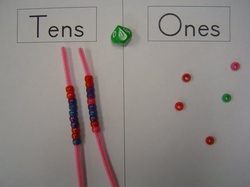
Play alone or with a partner. Roll a dice (I used10 sided) Put that number of beads on the ones side. Take turns rolling and adding beads. When you can make a 10 put the beads on a pipe cleaner cut in half to keep them together and reinforce the concept of 10 being 1 unit. Play until the student reaches 50 or the first student to reach 50 wins.
I love the cubes for calendar
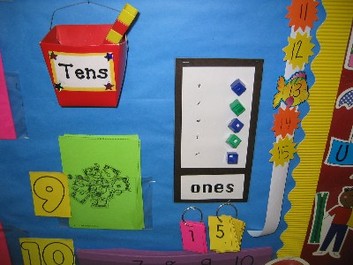
Grades 2-3 Look Here...
YOUTUBE: Math Rocks! Ones, Tens, and Hundreds
Place Value Download: Easy Spinner Game using expanded, standard, and word form. Download Below...
| spinningpv.pdf | |
| File Size: | 37 kb |
| File Type: | |
If you don't have place value mats- make these!

These Place Value Mats are made with one large sheet of construction paper (12 x 18") with a middle section (12 x 6") glued on top, in the middle. Then all you have to do is place titles at the top of each section and laminate. I actually had a parent volunteer put these all together (gotta love those volunteers)!
I love how they are so BIG and easy for my students to use!
I love how they are so BIG and easy for my students to use!

Here is a math center activity used to reinforce place value.
How to Play?
OR
How to Play?
- Place the deck of cards with the numbers facing up.
- Pick a card and try to stamp what it looks like using base 10 block stamps.
- Flip the card over to check your answer (self-correcting feature)
OR
- Place the deck of cards with the numbers facing up.
- Pick a card and try to BUILD what it looks like using base 10 blocks on a place value mat.
- Flip the card over to check your answer.(self-correcting feature)
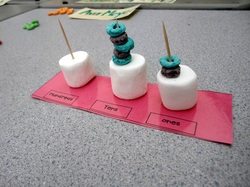
Here, students build the number on the marshmallows. This activity is easily adapted for any grade. Teacher could call out a number, partners, draw a number, etc....the possibilities are endless. Yummy Math!
Place Value Powerpoint (Ones, Tens, Hundreds) 2nd and 3rd Grade
| placevalue_day_1.ppt | |
| File Size: | 6943 kb |
| File Type: | ppt |
Rolling Place Value Practice

Math center idea for tens and ones. I use foam dice so they don’t make any noise. Student rolls 2 dice. The 1st number is for the tens place and the 2nd one is for the ones place. If they roll a 6 and 4 they write down 64 and then they draw the picture. You can add more dice for larger numbers. **Adaptation- add one, ten, hundred, thousand to the number rolled
Another Place Value Game for a Variety of Grade Levels
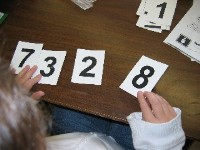
Place Value Game: Students use number cards to create the largest number possible. Materials:
- Deck of digit cards for each set of partners (2-4 each of #0-9, depending on the level of students and the size of the numbers they will create) Note: Spinners with #0-9 may be used instead of cards, if desired.
- Place value mat for each player.
- Recording sheet, if desired.
- Partner A turns over the first card and decides where to place that card on his/her place value mat. Once the card is placed, it may not be moved.
- Partner B turns over a card and decides where to place that card on his/her place value mat. Again, the card may not be moved once it is placed.
- Play continues with each partner turning over a card and deciding where to place it on the place value mat in hopes of building the largest number.
- When all slots are filled on the place value mats, partners compare numbers to see who created the larger number. That partner wins a point for the round.
- Partners record both numbers on their recording sheet and circle the larger number
- Students clear their mats, shuffle the cards and play additional rounds, as time allows.
- Students try to form the smallest number.
- Students try to form a number that is closest to 500 (or 2000 or...)
- Students try to form a number that is less than 1000.
- Students form numbers and earn a different number of points, depending on the range within which the number falls (e.g. 1 point for numbers from 0-500, 2 points for numbers from 501-1000, etc.)
Place Value Video to thousands
Place Value Pyramid Game
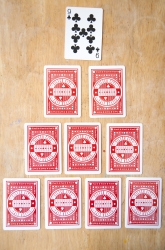
What You Need:
- One deck of playing cards (Print a deck.)
- Paper and pencil (to record scores)
- Remove the 10s and face cards from the deck. If you have jokers, keep them in the deck and have them count as zeros.
- Lay out nine cards for each player, face down, in the shape of a pyramid. One card should be in the top row, two cards in the second row, three cards in the third row, and four cards in the fourth row.
- Players begin by turning over the top card. The player with the highest card wins a point. If there is a tie, players each win a point.
- Players then turn over their second row of two cards. These cards represent two-digit numbers. The player with the highest two-digit number wins two points.
- Turn over the third row of cards. The player with the highest three-digit number wins three points.
- Turn over the last row of cards. The player with the highest four-digit number wins four points.
- Shuffle the cards and play another round.
- The first player to reach 25 points wins the game.
Place Value with Cups- Works for any level

An oldie, but a goodie for place value!
Race ya there Game!
Race Ya There!This is one of my favorite place value games. To play, each child will need aplace value chart and some base 10 blocks or other place value manipulatives. On a turn, a child rolls two dice and makes that number with the blocks. if there are more than 9 ones at any time, the child has to regroup by trading 10 ones with 1 ten in the tens place. Children take turns rolling the dice and making numbers on their chart.
Play continues until one child reaches 50, but this can be a little difficult, because the child has to roll a number that gets them exactly to 50.
Skill Note: To practice subtraction, children can also play the reverse of this game, "Race Ya Back". Start with 50 as 5 tens markers in the tens place. As children roll, they take away numbers, regrouping as necessary to give themselves more ones before taking them away. This is a harder skill than addition regrouping, and therefore will need a lot of practice. This is a game that is hard to get sick of, and teaches kids as they play, so feel free to break this one out often. The kids won't complain.
GREAT GAME!!! Watch video and learn how to play! Easy adaptation- Use an egg carton.
Place Value Draw
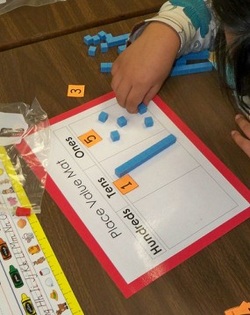
I have a favorite place value game for practicing the value of numbers. I give each student a blank piece of paper containing grids labeled Ones, Tens, Hundreds, Thousands, and Ten Thousands. I also prepare a stack of large cards each printed with one single-digit numeral 0-9. (The deck features multiples cards printed with the same digit.) The goal of the game is to see which student builds the largest number. I pull a total of 5 cards for students to see. Each time I show a card, students must choose a column in which to write the numeral displayed on the card. For example, if the first numeral I pull is a 9, students with strong number sense automatically write the 9 in the ten thousands column because they know that 9 has the highest value. If I pull a 3 first, it is trickier because students have to decide which spot might be the best for it. As we keep playing, it is very interesting to observe how students’ sense of place value increases. This game works great for formative assessment and students really enjoy the fun mix of strategy and luck inherent in this game.
Place Value Jeopardy (good review for 4-5 too)
| jeopardy_place_value_only.ppt | |
| File Size: | 416 kb |
| File Type: | ppt |
Place Value People

As part of our study of place value, I do a kinesthetic activity all year which seems to help everyone "get it" a little better.
I have digits written on construction paper and laminated: One number per piece of construction paper. I also have a piece with a comma that says thousand, a comma that says million, and a decimal point that says and.
I pass out the digits, commas, and decimal point randomly to students. Then I make up a number and tell the class. As I say the number, students with corresponding digits go to the front of the room to make the number. They line up and form the number for us by holding the card in front of their chest so we can see it. I usually let them collaborate some, but I really want them to do some independent thinking. It helps me to see who is still struggling with the concept. Once they think they are set, I have another student who didn't have a digit, read us the number. This is good practice for them as well.
After we are done with that number, students hand out their digits to classmates who don't have one, and we start the whole process all over again.
Sometimes, when they have the number made, I will say "Let's reduce this number by 20,000." (or something like that) Then students have to figure out who is affected by this change and who would come take their place. It is a pretty good activity that we use all year long!
I have digits written on construction paper and laminated: One number per piece of construction paper. I also have a piece with a comma that says thousand, a comma that says million, and a decimal point that says and.
I pass out the digits, commas, and decimal point randomly to students. Then I make up a number and tell the class. As I say the number, students with corresponding digits go to the front of the room to make the number. They line up and form the number for us by holding the card in front of their chest so we can see it. I usually let them collaborate some, but I really want them to do some independent thinking. It helps me to see who is still struggling with the concept. Once they think they are set, I have another student who didn't have a digit, read us the number. This is good practice for them as well.
After we are done with that number, students hand out their digits to classmates who don't have one, and we start the whole process all over again.
Sometimes, when they have the number made, I will say "Let's reduce this number by 20,000." (or something like that) Then students have to figure out who is affected by this change and who would come take their place. It is a pretty good activity that we use all year long!
Grades 4-5
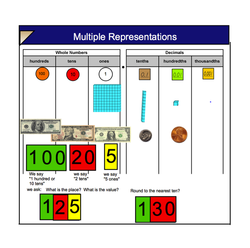
Here's a look at place value in upper grades. I love the multiple representations.
IDEA 4:

Upper Grades Place Value Game
Upper Grades Place Value Rap
Hands on practice with decimals.
| models_for_decimal_place_value.docx | |
| File Size: | 225 kb |
| File Type: | docx |
Upper Grade Place Value Game from TPT
Download Below
| backtoschoolplacevalueroundingblasttofreebie.pdf | |
| File Size: | 1142 kb |
| File Type: | |
6th Grade Rocks!
Dividing Fractions Game

Some of my students favorite math games during tutoring involve a deck of cards. They never tire of them.
Over the last few years, I've come up with several ways to play with a deck of cards. The above picture is one where my students are dividing fractions. I like using a deck of cards because it makes it fun and saves me the hassle of having to come up or find a worksheet with fractions on it.
We just use a white board and make the appropriate boxes and then draw from the deck. On the board you draw two squares over the top of each other. Then write a divide sign and then another set of squares.The student decides where to put the numbers.
The goal of the game is to get the most points. Before you put cards down on the white board, you need to decide if you are playing for HIGH or LOW numbers.
You can make a spinner on the white board with a circle drawn into two equal pieces. One one side of the circle write HIGH and on the other write LOW. Using a paper clip in the center of the circle, place a pencil in the paper clip and flick it with your finger.
1. Spin for HIGH or LOW
2. Each person draws cards and places them on their own board
3. Each player solves their set of cards
4. Whoever has the number that is bigger or smaller (decided by the spin) gets a point
5. Continue play until the first player reaches 10 points.
Over the last few years, I've come up with several ways to play with a deck of cards. The above picture is one where my students are dividing fractions. I like using a deck of cards because it makes it fun and saves me the hassle of having to come up or find a worksheet with fractions on it.
We just use a white board and make the appropriate boxes and then draw from the deck. On the board you draw two squares over the top of each other. Then write a divide sign and then another set of squares.The student decides where to put the numbers.
The goal of the game is to get the most points. Before you put cards down on the white board, you need to decide if you are playing for HIGH or LOW numbers.
You can make a spinner on the white board with a circle drawn into two equal pieces. One one side of the circle write HIGH and on the other write LOW. Using a paper clip in the center of the circle, place a pencil in the paper clip and flick it with your finger.
1. Spin for HIGH or LOW
2. Each person draws cards and places them on their own board
3. Each player solves their set of cards
4. Whoever has the number that is bigger or smaller (decided by the spin) gets a point
5. Continue play until the first player reaches 10 points.
Integers Powerpoint
| integers1-2.ppt | |
| File Size: | 2028 kb |
| File Type: | ppt |
Positive and Negative Number Game
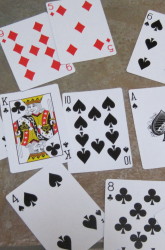
The concept of positive and negative numbers can be confusing! Check out this fun, competitive card game and improve your understanding. Work in a small group of 2 to 5 players. Help each other determine which cards have the greatest value. By working together, you'll ensure that no one feels left out, and everyone will gain confidence in no time!
What You Need:
What You Do:
What You Need:
- Deck of cards
What You Do:
- Shuffle the deck of cards. Divide the deck evenly among the players. Players should each keep their cards face down in a single stack.
- For the purposes of this game, red cards will represent negative numbers and black cards will represent positive numbers. (aces = +/-1, jacks = +/-11, queens = +/-12, kings = +/-13)
- Begin with players simultaneously turning over one card from the top of their packs. The winner of the round is determined by who turns over the card with the highest value. The winner gathers the cards from that round and places them at the bottom of their stack.
- The winner of the game is the player who accumulates all of the cards, or has the most cards when time runs out.
6th Grade Common Core Math Games and Links
| 6thgradeccmath.pdf_-_google_docs.webarchive | |
| File Size: | 1647 kb |
| File Type: | webarchive |
Integer Fear Factor- Download
| integerfearfactor.pdf_-_google_docs.webarchive | |
| File Size: | 1549 kb |
| File Type: | webarchive |
Factor Race Game Download Below
| factorracemathgame.pdf | |
| File Size: | 1030 kb |
| File Type: | |
Game Stop!
Games to download
| more-less-number-grids.pdf | |
| File Size: | 96 kb |
| File Type: | |
| beeplacevaluefreebie2.pdf | |
| File Size: | 1627 kb |
| File Type: | |
| placevaluegofishmathcenter.pdf | |
| File Size: | 12121 kb |
| File Type: | |
| placevalueblast.pdf | |
| File Size: | 1072 kb |
| File Type: | |
| placevaluematchupgame.pdf | |
| File Size: | 273 kb |
| File Type: | |
